SPIKE™ Essential
Your School Creation
It's time to create your very own invention for the team's classroom!
45-90 min.
Beginner
Years 3-5

Prepare
NOTE: This lesson will extend over two 45-minute class sessions.
- Review the Your School Creation lesson in the LEGO® Education SPIKE™ App.
- Consider the abilities and backgrounds of all your pupils. Differentiate the lesson to make it accessible to everyone. Please refer to the Differentiation section below for suggestions on how to do this.
- If time permits, plan and facilitate the language arts extension. Please refer to the Extension section below for further information.
PART A (45 Minutes)
Engage
(Whole Class, 10 Minutes)
- Facilitate a quick discussion about designing something new.
- Talk with your pupils about creating something new to help them during their school day.
- Ask questions like these: What would be the most useful thing that you could create for your classroom?
- Introduce your pupils to the team and the challenge: brainstorming a new creation for the team’s classroom.
- Distribute a brick set, any additional brainstorming materials and a device to each group.
Explore
(Small Groups, 25 Minutes)
- Have your pupils use the LEGO® Education SPIKE™ App to guide them through their first challenge:
- Design a new creation for the team’s classroom. Use at least one motor or sensor (i.e. Colour Sensor or Light).
- Your pupils can brainstorm using the LEGO bricks supplemented with additional materials. Encourage them to think of multiple solutions.
Explain
(Whole Class, 10 Minutes)
- Facilitate a sharing session in which your pupils present their initial ideas and provide feedback and suggestions to their peers.
PART B (45 Minutes)
Elaborate
(Small Groups, 30 Minutes)
- Have your pupils build, program and test the prototypes and ideas that they came up with during the brainstorming session in Part A of this lesson.
- Remind them to use at least one motor or sensor.
- Encourage them to test and refine their models and programs over 2-3 iterations.
- You can find coding and building help in the Tips section below.
Evaluate
(Whole Class, 15 Minutes)
- Ask guiding questions to encourage your pupils to ‘think aloud’ and explain their thought processes and reasoning in the decisions they’ve made while building and programming their models.
- Have your pupils tidy up their workstations.
Observation Checklist
- Measure your pupils’ proficiency in applying their engineering design skills to completing the given task.
- Establish a scale that suits your needs. For example:
- Requires additional support
- Can work independently
- Can teach others
Self-Assessment
Have each pupil choose the brick that they feel best represents their performance.
- Yellow: I think that I can design, build and program a solution.
- Blue: I can design, build and program a solution.
- Green: I can design, build and program a solution, and I can also
help a friend to do it.
Peer Feedback
- In their small groups, have your pupils discuss their experiences of working together.
- Encourage them to use statements like these:
- I liked it when you…
- I'd like to hear more about how you…
Tips
Coding Tips
- There are no coding instructions or Inspiration Coding Blocks for this lesson.
- Encourage your pupils to experiment and find their own solutions.
Model Tip
- There are no building instructions or Inspiration Images for this lesson.
- Encourage your pupils to create their own models.
- If they require further guidance, refer them to the building instructions for the previous lessons in this unit.
- There is no right or wrong model for this lesson.
- Your pupils can create entirely new models, find inspiration in the models from the previous lessons or simply recreate models from earlier lessons.
Differentiation
Simplify this lesson by:
- Reading the Your School Creation story aloud to your pupils
- Giving your pupils the building instructions from the previous lessons to use as inspiration for their new creations
Increase the difficulty by:
- Using two motors or sensors
- Creating two unique programs to make the solutions act in two different ways
Extension
- Have your pupils create advertisements for their new creations. They should include an opinion piece on why their creation is the best one for the team's classroom.
If facilitated, this will extend beyond the 90-minute lesson.
Language Arts: National Curriculum English En5/2.2 Comprehension b
Teacher Support
The pupils will:
- Apply engineering design skills to solving a problem
- Practice brainstorming as part of the design process
- Engage effectively in a range of collaborative discussions
(one for every two pupils)
- LEGO® Education SPIKETM Essential Set
- Device with the LEGO® Education SPIKE™ App installed
- OPTIONAL: Additional materials for brainstorming (e.g. notebook paper, science notebook, etc.)
National Curriculum
Design and Technology
DT2/1.1b
- generate, develop, model and communicate their ideas through discussion, annotated sketches, cross-sectional and exploded diagrams, prototypes, pattern pieces and computer-aided design
DT2/1.3b - evaluate their ideas and products against their own design criteria and consider the views of others to improve their work
English
En5/1g
- use spoken language to develop understanding through speculating, hypothesising, imagining and exploring ideas
En5/3.3b
Draft and write by: - selecting appropriate grammar and vocabulary, understanding how such choices can change and enhance meaning
- in narratives, describing settings, characters and atmosphere and integrating dialogue to convey character and advance the action
- précising longer passages
- using a wide range of devices to build cohesion within and across paragraphs
- using further organisational and presentational devices to structure text and to guide the reader




